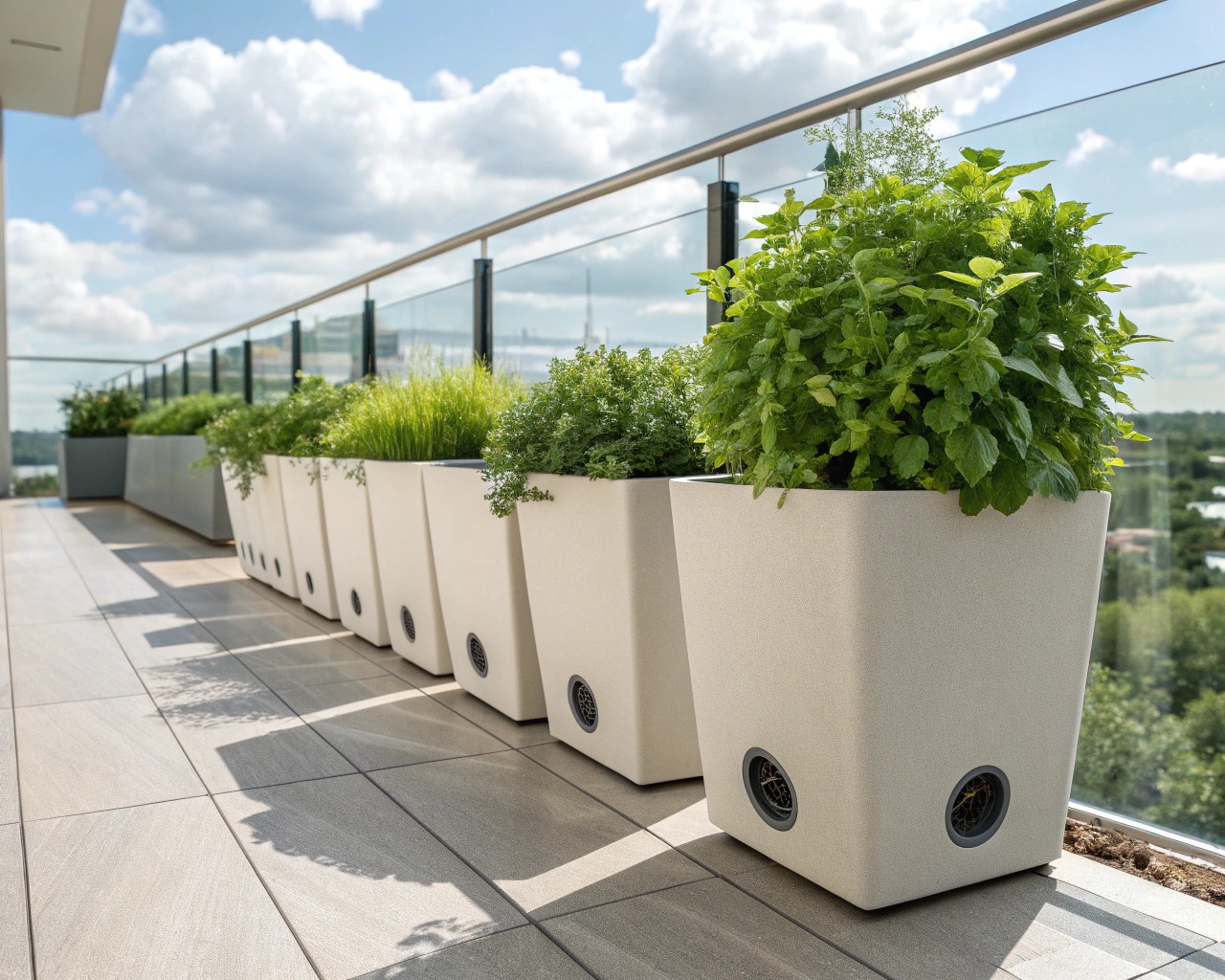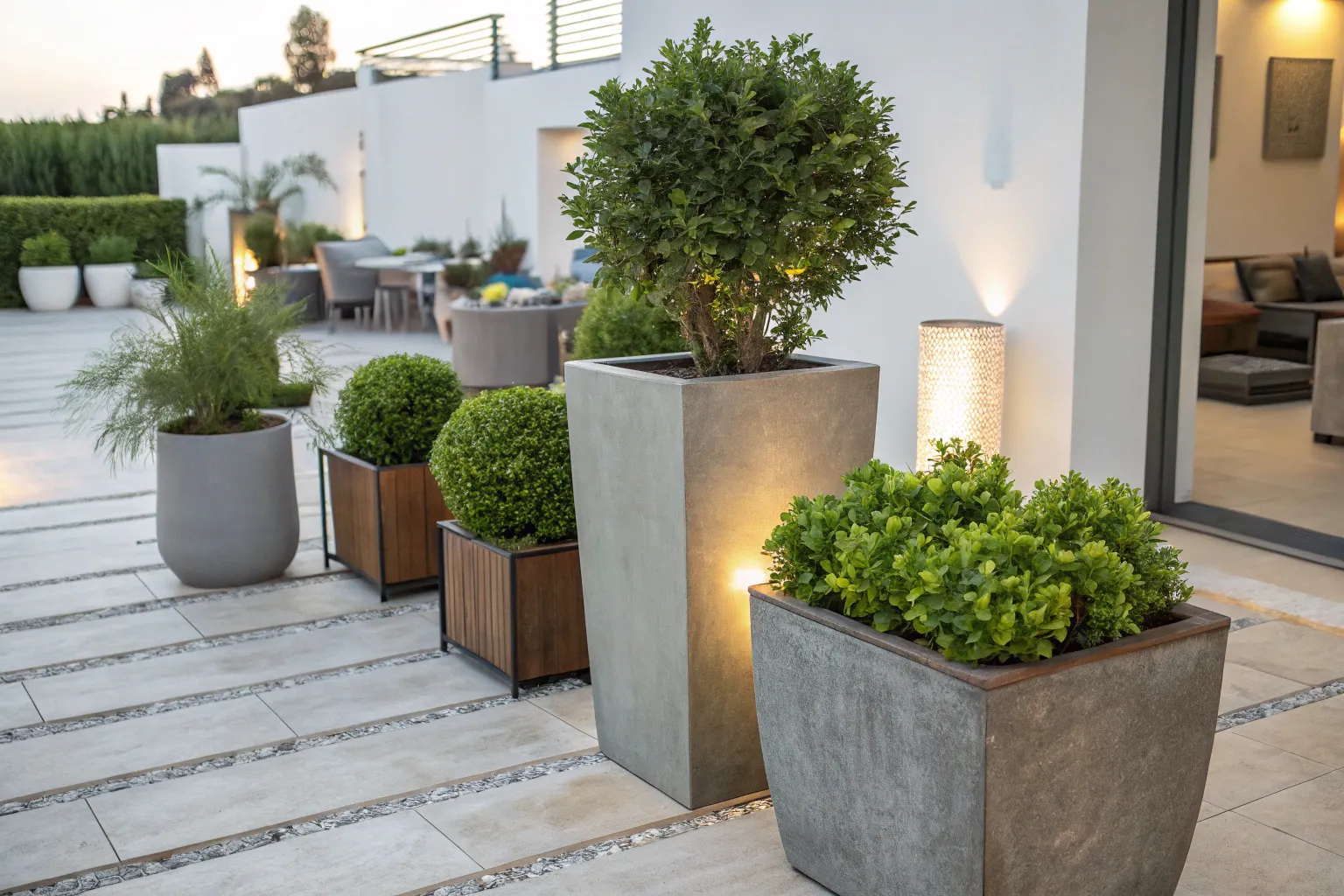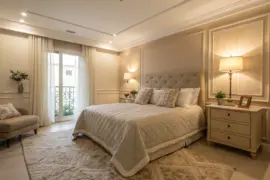Potscaping transforms ordinary spaces into dynamic compositions through intentional planter placement and plant selection. Rather than viewing containers as isolated afterthoughts, I approach them as architectural elements that shape outdoor rooms, guide movement, and create seasonal drama across patios, entryways, and gardens.
Understanding Spatial Design Before Plant Selection

The most common mistake in potscaping is starting with plant selection before considering spatial arrangement. Professional designers define spaces first, then use planters to reinforce those boundaries. This approach prevents the haphazard “leftover space” effect that plagues many container displays.
Think of your outdoor area as a series of rooms. Planters become walls, punctuation marks, and focal points that define these zones. A grouped arrangement of three large containers can separate a dining area from a lounge space without the permanence of built structures. Tall planters flanking a pathway create natural guidance for foot traffic, while a single dramatic planter at a path’s terminus acts as a visual destination.
When planning spatial arrangements, evaluate your area at different times of day. Shadows cast by overhangs and neighboring structures dramatically affect which plants will thrive. This preliminary observation saves significant frustration later.
The Rule of Thirds and Scale Relationships
Container proportion follows principles borrowed from visual arts. The rule of thirds dictates that either the container occupies one-third of the total height (container plus mature plants), with plants filling two-thirds, or the reverse ratio. For a 24-inch tall planter, your plants should eventually reach either 12 inches (creating a 36-inch total with the container as two-thirds) or 48 inches (creating a 72-inch total with the container as one-third).
Scale addresses how container size relates to its surroundings. A modest home requires substantial planters to make visual impact—what appears oversized at the garden center often looks appropriately scaled when positioned near architecture. For doorway placement, select containers tall enough to enter the sight line of approaching visitors, generally 20-24 inches minimum for standard residential entrances.
Container Size Guidelines
| Plant Type | Minimum Diameter | Depth Needed | Number of Plants |
|---|---|---|---|
| Small annuals | 10-12″ | 8-10″ | 3-4 |
| Medium perennials | 14-16″ | 12-14″ | 2-3 |
| Large grasses/shrubs | 18-24″ | 16-20″ | 1-2 |
| Dwarf trees | 24-36″ | 20-24″ | 1 |
| Mixed groupings | 16-20″ | 14-16″ | 5-7 |
Planter Material Selection
Material choice affects both aesthetics and plant health. Dark containers absorb more solar radiation, significantly increasing soil temperature—beneficial in cool climates but potentially damaging to heat-sensitive root systems in hot regions. Light-colored planters reflect heat, maintaining cooler root zones.
Planter Materials Comparison
| Material | Porosity | Weight | Insulation | Durability |
|—|—|—|—|
| Terra-cotta | High | Heavy | Moderate | Moderate (frost risk) |
| Glazed Ceramic | Low | Heavy | Good | Good |
| Fiber/Resin | None | Light | Poor | Excellent |
| Metal | None | Medium-Heavy | Poor | Excellent |
| Wood | Medium | Medium | Excellent | Moderate (decay risk) |
Porous materials like unglazed terra-cotta allow soil to breathe and naturally regulate moisture but require more frequent watering. Non-porous containers (metal, glazed ceramic, resin) demand precise drainage systems to prevent waterlogging.
Drainage Systems: The Foundation of Container Health

Proper drainage ranks as the single most critical factor in container success. Plants fail more frequently from drainage issues than from underwatering. Efficient drainage requires holes positioned on the sidewall approximately two inches above the container base rather than at the bottom. This placement creates a small water reservoir while preventing root submersion.
Drainage Layer Assembly
For containers taller than 18 inches, follow this layering sequence from bottom to top:
- Base weight layer: Rocks, bricks, or concrete blocks for stability (critical for tall planters to prevent tipping)
- Drainage layer: 2-3 inches of expanded clay pellets, gravel, or broken pottery shards
- Filter fabric: Landscape fabric or mesh screen to prevent soil migration into drainage layer
- Growing medium: Professional-grade potting mix (never garden soil)
The drainage layer allows excess water to flow away from roots while the filter fabric prevents fine soil particles from clogging drainage passages.
Professional Potting Mix Formulation
Garden soil compacts severely in containers, suffocating roots and creating anaerobic conditions. Professional growers use soilless mixes engineered for container environments. A reliable formula combines:
- 3 parts coconut coir or peat moss (moisture retention and structure)
- 2 parts aged compost (nutrients and beneficial microorganisms)
- ½ part perlite (aeration and drainage)
- ½ part vermiculite (moisture retention and nutrient holding capacity)
This “3:2:1” ratio creates a medium that drains efficiently while retaining adequate moisture and nutrients. For heavy-feeding annuals, incorporate slow-release granular fertilizer at planting time according to package directions.
The Thriller-Filler-Spiller Framework

This design principle creates dimensional interest by varying plant heights and growth habits.
Thrillers provide vertical architecture and serve as the focal point. Position one thriller slightly off-center rather than dead-center for a more dynamic composition. Effective thrillers include ornamental grasses (Pennisetum, Miscanthus), upright tropical foliage (Canna, Cordyline), and architectural perennials like Phormium (New Zealand flax).
Fillers occupy the middle zone, adding mass and color around the thriller. Use 2-4 filler plants depending on container size. Select fillers with similar vigor to your thriller—pairing slow-growing plants with aggressive varieties results in an unbalanced composition where one species dominates. Good fillers include Coleus, Heuchera, compact Salvia, and Angelonia.
Spillers cascade over container edges, softening hard lines and creating visual connection to the ground. Position spillers near the container rim with 1-2 inches of space from the edge to allow root expansion. Reliable spillers include Lysimachia ‘Aurea’ (golden creeping Jenny), Ipomoea batatas (sweet potato vine), and Bacopa.
Plant Placement Geometry
Proper spacing prevents overcrowding while ensuring the container fills attractively within three to four weeks.
For 3 plants: Arrange in an equilateral triangle within round containers, or use two plants at the back with one centered at the front in semi-circular planters.
For 4 plants: Create a square formation in round containers, or use a checkerboard pattern (two front, two back) in rectangular planters.
For 5 plants: Place four in a square with one centered, or arrange in a triangular formation with two middle plants in round containers.
Leave one to two inches between the container edge and plant root balls to allow lateral root growth. Insufficient edge space restricts root expansion and causes plants to become rootbound prematurely.
Matching Plant Vigor
Uneven growth rates create the most common container failures. Vigorous plants like Petunia ‘Supertunia Vista’ grow rapidly and overwhelm slow-growing companions, requiring constant pruning to maintain balance. Instead, pair vigorous plants together—combining Supertunia with equally aggressive Coleus cultivars creates a balanced display where no single plant dominates.
Plant tags often include spacing recommendations for in-ground plantings. Varieties suggesting 12-inch spacing grow more vigorously than those recommending 6-inch spacing—use this information to match vigor levels within containers.
Color Theory Application
Color relationships determine whether containers feel cohesive or chaotic.
Monochromatic schemes use varying shades of a single color (light pink through deep magenta). This approach feels sophisticated and allows texture to take center stage.
Analogous combinations employ three adjacent colors on the color wheel—yellow, orange, and red create warm, energetic displays, while blue, purple, and violet evoke calm.
Complementary pairings use opposite colors (purple and yellow, blue and orange) for maximum vibrancy and visual impact.
Split-complementary schemes start with one color and add the two colors adjacent to its complement. A container featuring violet flowers with orange and yellow-orange foliage demonstrates this technique.
Green foliage functions as a neutral element that bridges color relationships. When combining multiple flower colors feels busy, rely on foliage plants with chartreuse, bronze, silver, or variegated leaves to provide color interest while maintaining cohesion.
Texture and Foliage Contrast
Texture creates sophistication that color alone cannot achieve. Combine plants with distinctly different leaf characteristics:
- Bold foliage: Large, smooth leaves (Hosta, Colocasia, Caladium)
- Fine texture: Delicate, small leaves (Asparagus fern, dwarf grasses, Bacopa)
- Coarse texture: Rough, heavily veined leaves (Begonia, Coleus, Caladium)
- Linear forms: Grass-like or strap-shaped leaves (Carex, Acorus, Phormium)
A container combining bold Hosta leaves, fine-textured Asparagus fern, and linear Carex creates visual interest even with minimal color variation. The contrast in leaf size, shape, and surface quality provides depth that monochromatic color schemes might otherwise lack.
Foliage color adds another layer of design opportunity. Chartreuse leaves (Lysimachia, Coleus ‘Lime Time’) pop against dark purple or burgundy companions. Silver foliage (Artemisia, Helichrysum) harmonizes with cool blues and pinks, while bronze leaves (Heuchera ‘Palace Purple’) complement warm oranges and reds.
Creating Rhythm and Repetition

Rhythm guides the eye through a landscape by repeating elements at intervals. In potscaping, this might involve:
- Placing identical planters at regular intervals along a deck railing or property line
- Repeating the same plant species in multiple containers throughout the space
- Using a consistent color palette across different container groupings
The spacing between repeated elements affects pacing. Containers placed 6 feet apart create a leisurely rhythm, while 3-foot intervals generate more energy and movement. Varying the spacing slightly (alternating between 4 and 6 feet) adds subtle interest without breaking the rhythm entirely.
For larger properties, repeating planter materials or shapes in different areas creates unity. Gray slate containers near the patio echo similar containers at the entrance, tying distinct zones together even when plant selections differ.
Grouping Containers for Visual Impact
Single containers rarely make adequate impact. Grouping three or more creates a cohesive display with greater presence.
The Rule of Three: Arrange containers in three different sizes and heights. Stagger them rather than lining them up, positioning the tallest container slightly back and off-center. Place medium and small containers forward and to alternating sides.
Uneven numbers (3, 5, 7 containers) generally appear more natural and dynamic than even numbers. For symmetrical formal entries, however, even numbers work well when flanking doorways or steps—two identical planters on either side create intentional balance.
Height variation adds dimension to grouped displays. Use bricks, flagstone, or repurposed wooden stools to elevate some containers within the grouping. This tiered approach shows off trailing plants and prevents shorter containers from disappearing behind taller neighbors.
Seasonal Transitions
Effective potscaping extends beyond a single season. Containers can transition smoothly from spring through winter with strategic plant selection and replanting.
Spring containers emphasize fresh color and emerging growth. Combine early-blooming bulbs (Tulipa, Narcissus) with cool-season annuals (Viola, Primula) and emerging perennials.
Summer displays peak with heat-loving annuals and tropical foliage. This season allows for the boldest color combinations and most exuberant growth. Focus on heat-tolerant, drought-resistant plants for low-maintenance summer containers.
Fall transitions introduce richer, deeper colors and emphasize texture through ornamental grasses, late-blooming perennials (Aster, Sedum), and foliage plants with burgundy or bronze tones. Many summer containers can transition to fall by removing spent annuals and adding ornamental kale, pansies, and chrysanthemums.
Winter interest relies on evergreen structure and persistent elements. Dwarf conifers (Pinus mugo, Abies koreana), broad-leaved evergreens (Skimmia, Leucothoe), and ornamental grasses that hold their form provide structure when most plants are dormant.
Rather than completely replanting containers each season, I often retain one or two strong structural plants (typically evergreens) and swap out seasonal companions. This approach reduces replanting labor while maintaining year-round interest.
Evergreens: The Backbone of Year-Round Potscaping
Evergreen plants provide consistent structure and require significantly less maintenance than seasonal annuals. Incorporating at least one evergreen per container creates a foundation that carries through winter dormancy.
Top performers for container evergreens:
- Dwarf conifers: Pinus mugo ‘Pumilio’ (dwarf mountain pine), Abies koreana (Korean fir)—slow growth rate and cold tolerance
- Architectural forms: Phormium (New Zealand flax), Yucca species—dramatic structure and drought tolerance
- Broad-leaved evergreens: Fatsia japonica, Skimmia species—shade tolerance and winter interest
- Evergreen grasses: Festuca glauca (blue fescue), Carex species—fine texture and movement
- Trailing evergreens: Hedera helix (ivy), Vinca minor—cascading habit for year-round softening
When growing evergreens in containers, account for reduced cold hardiness. Roots in above-ground containers experience more extreme temperature fluctuations than in-ground plantings. Select plants rated for at least one zone colder than your region (Zone 5 gardeners should choose Zone 4-hardy plants for containers).
Strategic Placement for Function
Container placement accomplishes specific functional goals beyond aesthetics.
Entryway flanking: Symmetrical containers on either side of a door create formal welcome. Select tall containers (minimum 24 inches) with substantial plantings that remain attractive through multiple seasons.
Privacy screens: Large planters with tall grasses, bamboo, or shrubs create instant privacy without permanent installation. Position 3-5 large containers in a staggered line to obscure sight lines.
Space definition: Containers placed at the boundary between two outdoor zones (dining area and lounge, patio and lawn) psychologically separate functions without physical barriers.
Traffic control: Strategically placed containers guide pedestrian movement and prevent shortcuts across sensitive areas. A large container at a path junction directs foot traffic while serving as a destination focal point.
Seasonal flexibility: Unlike permanent plantings, containers relocate easily to accommodate changing needs. Summer containers might occupy prominent patio positions, then move to less visible locations in winter when evergreen alternatives take center stage.
Watering and Moisture Management
Container plants require more frequent irrigation than in-ground plantings due to limited soil volume and increased evaporation. During peak summer temperatures, containers may need daily watering, sometimes twice daily for small pots or vigorous plants.
Proper watering technique: Water thoroughly until moisture drains freely from the bottom. This ensures complete soil saturation and flushes accumulated salts from fertilizer. Shallow watering encourages surface roots rather than deep, drought-resistant root systems.
Moisture monitoring: Check soil moisture by inserting a finger 1-2 inches into the potting mix. When this depth feels dry, water thoroughly. Container surfaces may appear dry while deeper soil remains moist—surface dryness alone isn’t a reliable indicator.
Reducing water needs: Apply 1-2 inches of organic mulch over the soil surface to reduce evaporation. Group containers together to create a more humid microclimate that slows moisture loss. Move containers to shadier locations during extreme heat to reduce transpiration stress.
For vacation periods or inconsistent watering schedules, consider self-watering containers with built-in reservoirs. These systems provide steady moisture delivery, reducing daily watering demands.
Fertilization Strategy
Frequent watering leaches nutrients from container soil more rapidly than in-ground situations. Containers require more intensive fertilization than garden beds.
Two-stage approach:
-
Slow-release granular fertilizer incorporated into potting mix at planting provides baseline nutrition for 3-6 months. Follow package application rates based on container volume.
-
Liquid fertilizer supplements beginning 4-6 weeks after planting. Apply water-soluble balanced fertilizer (10-10-10 or 20-20-20) at half strength every 2-3 weeks through the growing season.
For flowering containers, switch to bloom-boosting formulations (higher middle number, such as 10-30-20) once flower buds form to support flower production. Reduce or eliminate fertilization after late summer to allow plants to harden off before dormancy.
Signs of nutrient deficiency: Yellowing leaves (particularly older, lower leaves), stunted growth, and reduced flowering indicate insufficient nutrition. Increase fertilization frequency rather than concentration to address deficiencies.
Troubleshooting Common Problems
Root-bound plants: Symptoms include roots circling the container interior, growth out of drainage holes, and rapid soil drying despite frequent watering. To correct, remove the plant and use your fingers or a tool to loosen circling roots, even if this requires cutting through some root mass. Prune up to one-third of root volume if severely bound, then repot in fresh soil.
Overwatering: Yellowing leaves, wilting despite moist soil, and fungal growth on soil surfaces indicate overwatering. Ensure adequate drainage holes, reduce watering frequency, and check that drainage layers aren’t clogged.
Uneven plant growth: When one plant overtakes others in a mixed container, it usually indicates mismatched vigor levels. Either prune the aggressive plant heavily or separate plants into individual containers matched to their growth rates.
Salt buildup: White crusty deposits on soil surface or container rims indicate salt accumulation from hard water or excess fertilizer. Flush containers thoroughly by running water through them for several minutes, allowing complete drainage. Reduce fertilization frequency.
Wilting in hot weather: Even well-watered containers may wilt during extreme heat. Temporarily move containers to shadier locations during heat waves, or create temporary shade with umbrellas or shade cloth.
Potscaping Styles
The overall design approach varies with architectural style and personal preference.
Contemporary style: Clean-lined containers (rectangular fiber-resin or metal) with monochromatic or limited color palettes. Emphasize sculptural plants like Phormium, ornamental grasses, and succulents. Use asymmetrical arrangements and negative space.
Cottage garden style: Mix colorful annuals and perennials in aged terra-cotta or ceramic containers. Layer multiple plant types with loose, abundant arrangements. Incorporate edible herbs and vegetables alongside ornamentals for the traditional cottage garden approach.
Formal style: Symmetrical arrangements with matching containers flanking entries or positioned at regular intervals. Use topiary forms, clipped evergreens, and restrained color palettes. Maintain precise balance and geometric placement.
Modern cottage fusion: Contemporary materials and structure combined with loose, naturalistic planting. Use repeated plant groupings in generous drifts rather than one each of many varieties. Follow a 70/30 rule: 70% of plants in larger, repeated groupings, 30% accent plants for variation.
Regardless of style, maintain consistency within each project. Mixing too many container styles, colors, and planting approaches creates visual chaos rather than intentional eclecticism.
Professional Installation Considerations
Timing significantly affects establishment success. In hot summer climates, install containers in spring or fall when temperatures moderate. Summer installations in extreme heat require intensive irrigation and result in higher plant mortality.
For large containers (over 24 inches diameter), partially fill them with lightweight filler materials before adding soil. Inverted plastic nursery pots, packing peanuts, or large-diameter PVC pipe sections reduce soil volume and overall weight without compromising plant health. This technique is particularly important for containers on balconies, decks, or other weight-sensitive locations.
Pre-planting preparation: Soak root balls of nursery plants briefly before planting to ensure complete hydration. Many nursery plants arrive rootbound—gently tease roots apart before planting to encourage outward growth rather than continued circling.
Acclimate newly installed containers gradually. Even sun-loving plants benefit from a few days of partial shade after transplanting to reduce stress while roots establish in their new environment.
The Professional Mindset
I view container design as creating portable gardens—complete ecosystems that just happen to be movable. This perspective shifts containers from decorative afterthoughts to intentional design elements that shape outdoor spaces with the same impact as permanent plantings.
Success comes from understanding that plants in containers exist in a fundamentally different environment than in-ground plantings. They have limited resources, greater exposure to environmental extremes, and depend entirely on the gardener for survival. Potscaping done well accounts for these constraints through material selection, drainage design, and plant choices that thrive under container conditions.
The best container designs balance immediate impact with longevity. While seasonal annuals provide maximum color, incorporating structural evergreens and well-chosen perennials creates interest across multiple seasons with reduced replanting labor. Think beyond peak bloom periods to consider how containers contribute to the landscape when plants are dormant or between flowering cycles.
Ultimately, potscaping succeeds when containers integrate seamlessly with the broader landscape rather than appearing as isolated decorative objects. Thoughtful placement, appropriate scale, and plant selections that reference surrounding plantings create cohesion between contained gardens and the larger outdoor environment.





